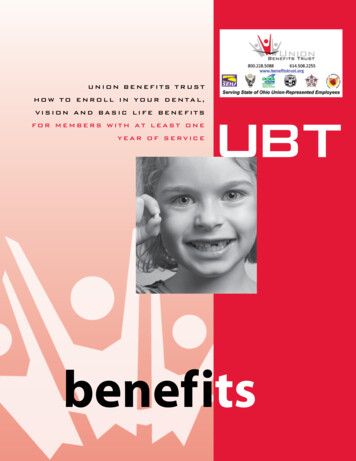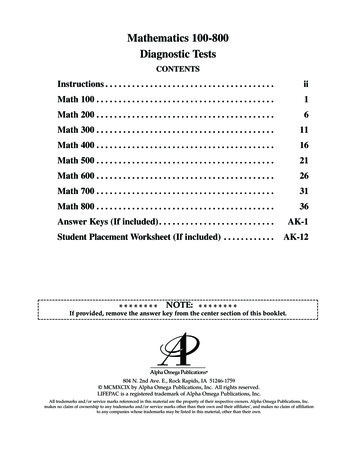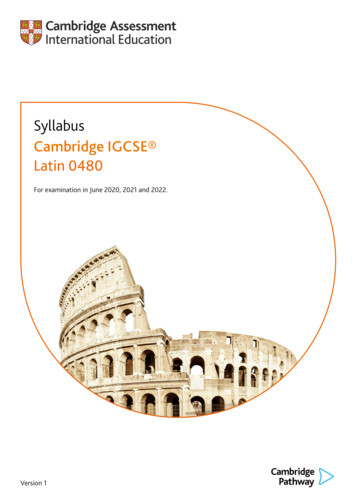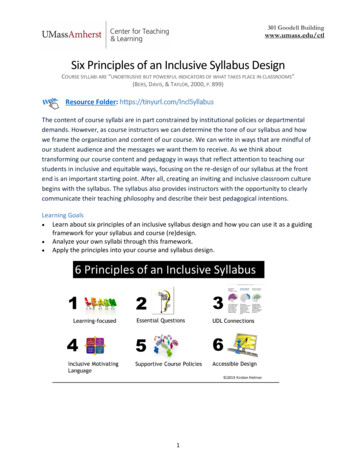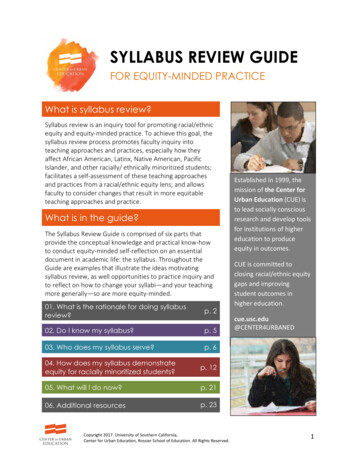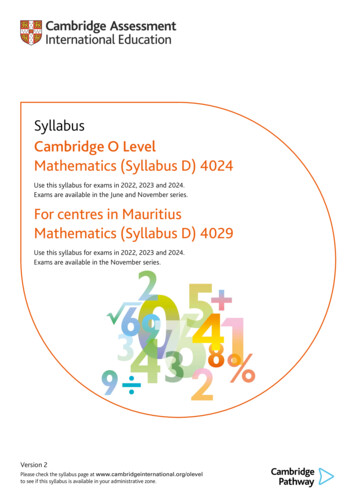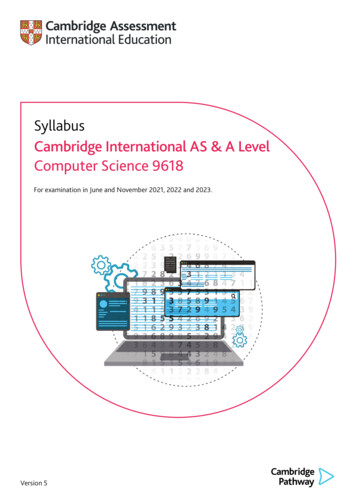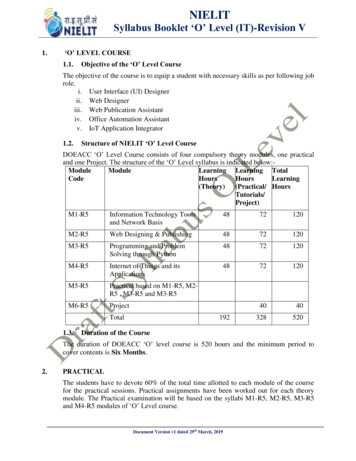
Transcription
NIELITSyllabus Booklet ‘O’ Level (IT)-Revision V1.‘O’ LEVEL COURSE1.1.Objective of the ‘O’ Level CourseThe objective of the course is to equip a student with necessary skills as per following jobrole.i. User Interface (UI) Designerii. Web Designeriii. Web Publication Assistantiv. Office Automation Assistantv. IoT Application Integrator1.2.Structure of NIELIT ‘O’ Level CourseDOEACC ‘O’ Level Course consists of four compulsory theory modules, one practicaland one Project. The structure of the ‘O’ Level syllabus is indicated below:ModuleModuleLearning Learning TotalCodeHoursHoursLearning(Theory) (Practical/ HoursTutorials/Project)M1-R5Information Technology Toolsand Network Basis4872120M2-R5Web Designing & Publishing4872120M3-R5Programming and ProblemSolving through Python4872120M4-R5Internet of Things and itsApplications4872120M5-R5Practical based on M1-R5, M2R5 , M3-R5 and M3-R5M6-R5Project4040328520Total1.3.192Duration of the CourseThe duration of DOEACC ‘O’ level course is 520 hours and the minimum period tocover contents is Six Months.2.PRACTICALThe students have to devote 60% of the total time allotted to each module of the coursefor the practical sessions. Practical assignments have been worked out for each theorymodule. The Practical examination will be based on the syllabi M1-R5, M2-R5, M3-R5and M4-R5 modules of ‘O’ Level course.Document Version v1 dated 29th March, 2019
NIELITSyllabus Booklet ‘O’ Level (IT)-Revision V3.PROJECTDOEACC curriculum has a project as an important component of ‘O’ Level course. TheProject is carried out by the student under guidance and support of faculty andmanagement of the respective Institute / Organization. It is felt that such a projectprovides an opportunity to the student to apply his / her knowledge and skills to real lifeproblems (including oral and written communication skills), and as such the projectshould be given utmost importance and priority both by the students as well as institutionfaculty / management in respect of its identification, planning and implementation.3.1.Objective of the ProjectThe objective of the project is to give the students an additional hand-on experience insolving a real life problem by applying knowledge and skills gained on completion oftheory papers in a course at a given Level. It provides an opportunity to students todevelop written and communication skills. Project also helps the students to realize theimportance of resource and time management, ownership of task towards deliverables,innovation and efficiency in task management apart from presentation skills. It alsoprovides a good opportunity for students to build, enhance and sustain high levels ofprofessional conduct and performance and evolves a problem solver frame of mind in thestudents. It is also felt that taking up the project by a student prepares him for a job inindustry and elsewhere.3.2.Project SubmissionThe student undergoing course ‘O’ level course has to submit project in order to be ‘O’Level certified. The project should be original, of real life value and not copies fromexisting material from any other source.The Learners are expected to carry out a project successfully and submit certificate in theprescribed format from the head of the institute running the accredited course or theorganization of which the Learner is an employee. Proforma of the Project CompletionCertificate is given as follow;Document Version v1 dated 29th March, 2019
NIELITSyllabus Booklet ‘O’ Level (IT)-Revision V4.CREDIT SCHEME FOR DOEACC ‘O’ LEVEL4.1.Course IntroductionA credit system based on the AICTE norms has been introduced for indicating the effortsrequired to pass a specific level of course under the DOEACC Scheme. Award of creditto a student will facilitate measurement/comparison of study hours including TheoryLectures, Tutorials and Practical Assignments put in a given module/paper/subject underthe Scheme with similar course in IT in India and abroad. This will also facilitate otherUniversities/ Apex Accrediting bodies to consider academic and professional equivalenceof DOEACC courses. This will also help students/organizations to transfer credits fromDOEACC to other academic bodies and vice-versa for ensuring continuing education.Following table gives the number of hours of Lectures/Tutorials and Practicals per weekto be attended and the credits earned by the student:4.2.Calculation of CreditsSr.No.ModuleCodeModule NameNo. ofLectureperweek(L)2No. ofTutorial/Practicalper week(T P)41.M1-R5Information Technologytools and Network Basis2.M2-R53.Web Designing &Publishing244M3-R5Programming andProblem Solvingthrough Python2444.M4-R5Internet of Things andits Application2445.M6-R5Project216.Total CreditsTotalCreditL (T P)/2417Notes1.One credit is defined as one hour of lecture and 2 hours of tutorials/ practicalevery week for one semester consisting of 20 weeks.2.Total number of credits earned in a module is calculated using AICTE formula (asapplicable to Under Graduate Courses in IT namely C L (T P)/2 where L, Tand P indicate number of hours per week for Lectures, Tutorials and Practicals.3.The credit scheme was implemented from July, 2003 examinations.4.Fractions in Credits have been rounded to nearest integer.Document Version v1 dated 29th March, 2019
NIELITSyllabus Booklet ‘O’ Level (IT)-Revision V5.EXAMINATION PATTERNThe theory examination for each module under the fifth revised syllabus would be forduration of three hours and the total marks for each subject would be 100. One Practicalexamination of three hours duration and would be of 100 marks. The first examinationwith the revised syllabus will be held in January 2020, for which teaching will commencewith immediate effect.Dates for the various activities connected with examinations will be announced onNIELIT website, well in advance of the examinations.Laboratory/ Practical work will be conducted at Institutions / organizations, which arerunning the course. NIELIT will be responsible for holding the examination for theoryand practical both for the students from Accredited Centers and student at large.5.1.Pass PercentageTo qualify for a pass in a module, a candidate must have obtained at least 50% in eachtheory, practical examination and project. Following table shows the marks mation Technology tools and Network Basis100M2-R5Web Designing & Publishing100M3-R5Programming and Problem Solving through Python100M4-R5Internet of Things and its Applications100M5-R5Practical based on M1-R5, M2-R5, M3-R5 and M4-R5100M6-R5Project (Certificate only to qualify O Level)Total Maximum Marks500The marks will be translated into grades, while communicating results to the candidates.The gradation structure is as below:Pass PercentageGradeFailed ( 50)F50%-54%D55%-64%C65%-74%B75%-84%A85% and overSDocument Version v1 dated 29th March, 2019
NIELITSyllabus Booklet ‘O’ Level (IT)-Revision V5.2.Award of CertificatesThe students would be eligible for the award of ‘O’ Level certificate on successfullyqualifying the Theory Examinations of all modules, Practical Examination and theProject. The ‘O’ Level Certificate was recognized as equivalent to Foundation LevelCourse by the Government of India for the purpose of employment vide Notification No.43 & 49 dated 1st March, 1995 and 10th April, 1996 respectively issued by the Ministry ofHRD, Government of India.5.3.RegistrationRegistration is a pre-requisite for appearing in ‘O’ Level examinations. A candidate canregister at only one Level at a time to appear for the examination. Registration is only forcandidates and not for institutes. Candidate has to register with NIELIT through onlineportal.5.4.Eligibility CriteriaThe eligibility criteria for registration at ‘O’ Level is as follows:5.4.1. Students from Institutes conducting accredited courses:10 2 or ITI Certificate (One Year) after class 10 followed in each case, by an accredited‘O’ Level course.OrSuccessful completion of the second year of a Government recognized polytechnicengineering diploma course after class 10, followed by an accredited ‘O’ Level courseconcurrently during the third year of the said polytechnic engineering diploma course.The certificate of ‘O’ level will be awarded only after successful completion of thepolytechnic engineering diploma.5.4.2. Direct Applicants10 2 or ITI Certificate (One Year) after class 10, followed in each case, by one-yearrelevant experience. Relevant experience connotes job experience in IT, includingteaching in a recognized institution as a faculty member, excludes coaching.OrA pass in the NCVT-DP&CS (data Preparation & Computer Software) Examination,conducted by DGE&T(Govt. of India)For getting registered, a candidate fulfilling the eligibility criteria should apply online inNIELIT portal. Registration fee is also to be paid online. Registration fee once paid is notreimbursable or adjustable against any other payment.Registration application can be submitted online throughout the year, however cut offdates are specified for submitting Registration applications for each examinations for theconvenience of processing and allotting Registration Numbers.Cut off DatesJanuary ExaminationJuly ExaminationthPreceding 30 JunePreceding 31st DecemberDocument Version v1 dated 29th March, 2019
NIELITSyllabus Booklet ‘O’ Level (IT)-Revision VAccredited Institutes are allowed to submit the Registration Application Form online oftheir candidates one month beyond the cut off dates.5.5.Auto-upgradation:The candidates successfully completing all papers (Theory, Practical and Project) of aparticular Level in a particular Examination and wish to appear in the next Examinationfor immediate higher Level are exempted from the above cut off dates. Such candidatescan fill up examinations Form and Registration Forms for higher Levels subject tofollowing conditions:a) Combined Registration fee and Examination fee is paid online.b) The facility is available to the candidates appearing through Accredited Institutesand not for direct applicants. However the facility is available to a candidate whomight have completed lower level as a direct candidate and wishing to appear forimmediate higher level through Accredited Institutes.c) The facility is also not available to the candidates those who might be appearingthrough Accredited institute but have cleared lower level prior to the precedingexam (e.g. if a candidate has passed ‘O’ Level Exam in Jan, 2019, he would beeligible for this facility in case he wishes to appear for ‘A’ Level Examinations inJuly, 2019 through Accredited Institute. If, however, he had passed ‘O’ Levelprior to Jan., 2019 Exams, this facility would not be available to him).d) This facility would also not be available to the candidate opting for Level jumping(e.g. from ‘O’ to ‘B’ or ‘A’ to ‘C’ Levels).Once registered at a particular level, the registration is valid for ten consecutiveexaminations for ‘O’ Level, reckoned from the specific examination as indicated in theRegistration allocation letter issued to the candidates.Registration, by itself, does not entitle a candidate to appear for an examination at theLevel concerned, unless all conditions, stipulated in the examination application form,and in any other notification, relevant to the examination are fulfilled by the candidate.5.6.Re-registration:Candidates who are not able to clear the level within the validity period of initialregistration, are allowed to re-register for once, at the same level for another full term i.e.5 years to clear the left over papers by submitting filled in Registration application andfull Registration fee within one year of the expiry of the validity period of existingRegistration.6.PRACTICAL EXAMINATION SCHEMEThe Practical Examination will be conducted by the NIELIT in reputed Institutions for allcandidates. The institutes are obliged to facilitate the conduct of Practical Examinationsand arrange infrastructure, support of its faculty and staff for the conduct of PracticalExamination at their Centre. The practical examination scheme is as follows.Number of Practical ExaminationDuration of Practical ExaminationOneThree hour duration including viva-voceDocument Version v1 dated 29th March, 2019
NIELITSyllabus Booklet ‘O’ Level (IT)-Revision VMax. Marks100 80(Practical) 20(Viva Voce)GradingMarks obtained by the students will betranslated into the Grades as per thestructure given Section 9.1.Date(s) will be announced on NIELITDate(s)website.The institutes are not allowed to charge any fee from the candidates, for the practicalexamination7.HARDWARE REQUIREMENT FOR ‘O’ LEVEL COURSE7.1.Computer configuration ptical DriveSpeaker, Mic, WebcamCD/DVD Writer::::::::::1 GHz or higher1 GB or higher100 GB or higherSVGAWindows Laser printer / Inkjet Printer:StandardDot matrix printerOHP /LCD Projector::StandardStandardMODEM, DIAL nt number of computers are standard networking are part of satisfying criteria foraccreditation.7.3.NetworkingNICRJ-45 ConnectorCrimping ToolsUTP/STP/Coaxial Fiber OpticCables and their connectors8/16 port Hub/SwitchWi-H ardStandardStandardStandardStandardDocument Version v1 dated 29th March, 2019
NIELITSyllabus Booklet ‘O’ Level (IT)-Revision V7.4.OthersArduino UNO or equivalent board sensors and motors1.SOFTWARE REQUIREMENT FOR ‘O’ LEVEL COURSESr. No.1.2.3.4.5.6.7.2.ParticularOperating SystemNOSSoftware PackageComplier/InterpreterAntivirusInternet and Web Windows/UnixLibreOffice, Star Office/ MSOffice or any relevant wordprocessing/spreadsheetPythonStandardStandard Browser andpublishing toolsArduino IDEArdoblockopen ToolPARITY TABLE BETWEEN REVISION IV and REVISION V of ‘O’ LEVELSYLLABUSModule Code(Revision IV)M1-R4M2-R4M3-R4M4.1-R4M4.2-R4M4.3-R4Revision IV(Module)IT Tools and BusinessSystemModule Code Revision V(Revision V) (Module)M1-R5InformationTechnology tools andNetwork BasisInternet Technology and M2-R5Web Designing &Web DesignPublishingProgramming andM1-R5Programming andProblem SolvingProblem SolvingThrough ‘C’ Languagethrough PythonApplication of .NETM1-R5Internet of ThingsTechnologyand its ApplicationsIntroduction toMultimediaIntroduction to ICTResources1. The above table shows the equivalence between the modules of old syllabus(Revision VI and V).2. Candidates would not be allowed to appear in the equivalent papers of theRevision IV (new syllabus), if they have already passed the relevant papers inearlier revision.3. Candidates would have to pass a total of 4 papers and one practical in order toqualify ‘O’ Level in Revision IV syllabus.Document Version v1 dated 29th March, 2019
NIELITSyllabus Booklet ‘O’ Level (IT)-Revision V4. In case, candidate has cleared examination as per Revision II and/or RevisionIII, the equivalency of Revision II with III and Revision III with IV will be donebefore the equivalency with Revision V is done.5. Candidates would be allowed exemption in equal number of papers which theyhave passed in Revision II or Revision III (old syllabus).Document Version v1 dated 29th March, 2019
NIELITSyllabus Booklet ‘O’ Level (IT)-Revision VAnnexure IDetailed Modules1. Module: M1-R5: IT Tools & Basics of Networks1.1. IntroductionThe module is designed to equip a student to use computers for professional as wellas day to day use. It provides theoretical background as well as in depthknowledge of Software/ packages.1.2. ObjectivesAfter completing the module, the incumbent will be able to: Acquire confidence in using computers in Office and General Life Identify the basic components of computers and terminology Understand file management Create documents using word processor, spreadsheet & presentationsoftware Understand computer networks, and browse the internet, content search,email and collaborate with peers Use e-Governance applications; and use computer to improve existing skillsand learn new skills Understanding Social Networking platform Using internet for Digital Financial services Develop knowledge about FutureSkills Understand the various financial services and be aware of the variousschemes started by Government.1.3. Duration120 Hours - (Theory: 48 hrs Practical: 72 hrs)1.4. Outline of ModuleModule Unit1. Introduction toComputerDuration(Theory)in Hours4Duration(Practical)in Hours6Learning ObjectivesAfter completion of this unit ofmodule, the Learner will beable toDocument Version v1 dated 29th March, 2019
NIELITSyllabus Booklet ‘O’ Level (IT)-Revision V2. Introduction toOperating System463. Word Processing69 Identifycomputers,ITgadgets and explain theirevolution and applications. Get familiar with variousinput, output and hardwarecomponents of a computeralong with storage devices. Get familiar with varioustypes of software, utilitiesused for computer andmobile apps.After learning this unit, Learnerwill be: WellacquaintedwithOperating System and itsapplicationsforbothdesktop and mobile devices. Able to identify variousdesktop screen componentsandmodifyvariousproperties, date, time etc. Able to add and remove newprogramandfeatures,manage files and folders. Well versed with printingand know various types offile extensions.After completion of this unit,Learner will have in depthknowledge of Word Processing, theirusage, details of wordprocessing screen Opening,savingandprintingadocumentincluding pdf files Documentcreation,formatting of text, paragraphand whole document Inserting Header and Footeron the document Finding text on a worddocument and correctingspellings Inserting and manipulatingDocument Version v1 dated 29th March, 2019
NIELITSyllabus Booklet ‘O’ Level (IT)-Revision V4. Spreadsheet8125. Presentation696. Introduction toInternet andWWW69tables, enhancing table usingborders and shading features Preparing copies of adocument labels etc. forsending various recipientsusing Mail Merge.After completion of this unit,Learner will have good handson practice on BasicKnowledgeofSpreadsheetProcessing,their usage, details ofSpreadsheet screen Opening,savingandprinting a Spreadsheet Spreadsheetcreation,inserting and editing data incells, sorting and filtering ofdata Inserting and deleting rows/columns Applying basic formulas andfunctions Preparing chart to representthe information in a pictorialform.After completion of this unit,Learner will have good handson practice on BasicKnowledgeofPowerPoint presentations. Opening/savingapresentation and printing ofslides and handouts Manipulatingslidestoenhance the look of theslides as well as wholepresentation by inserting apicture, objects, multimediaformatting etc. Running a slide show withvarious transitions.After completion of this unit,Learner will be able to Gatherknowledgeofvarious types of networksDocument Version v1 dated 29th March, 2019
NIELITSyllabus Booklet ‘O’ Level (IT)-Revision V7. E-mail, SocialNetworking ande-GovernanceServices698. Digital FinancialTools andApplications46and topologies Get an overview of Internet,its applications and variousbrowsers available to accessthe Internet Connect to Internet usingvariousmodesofconnections/devicesavailable Get knowledge of deviceidentificationonlocalnetwork as well as onInternet for both Desktopand Mobile Devices Can search Information onthe Internet on varioustopics Download and print webpages.After completion of this unit,Learner will be able to Create an email account,compose an email, reply anemail and send the emailalong with attachments Get familiar with SocialNetworking,InstantMessaging and Blogs Get familiar with eGovernance Services, eCommerce and MobileApps.After completion of this unit,Learner will be able to Know the Digital FinancialTools Get Knowledge of InternetBanking Modes Get familiar with eGovernance Services, eCommerce and Mobile Apps Use the Digital Locker andwill be able to storedocuments in Digital LockerDocument Version v1 dated 29th March, 2019
NIELITSyllabus Booklet ‘O’ Level (IT)-Revision V9. Overview ofFutureSkills &Cyber Security46After completion of this unit,Learner will be familiar withthe Latesttrendsandtechnologies in upcomingfields in IECT Need of Cyber Securityand will be able to securetheir PC and Mobiledevices by using basicsecurity features.1.5. Marks DistributionModule UnitWritten Marks(Max.)1. Introduction to Computer, Introduction toOperating System102. Word Processing203. Spreadsheet204. Presentation205. Introduction to Internet and WWW, E-mail,Social Networking and e-Governance Services206. Digital Financial Tools and Applications,Overview of FutureSkills & Cyber Security107. Total1001.6. Detailed Syllabus(i) Introduction to ComputerComputer and Latest IT gadgets, Evolution of Computers & its applications, ITgadgets and their applications, Basics of Hardware and Software, CentralProcessing Unit, Input devices, Output devices, Computer Memory & storage,Application Software, Systems Software, Utility Software, Open source andProprietary Software, Mobile Apps.(ii) Introduction to Operating SystemOperating System, Basics of Operating system, Operating Systems for Desktopand Laptop, Operating Systems for Mobile Phone and Tablets, User Interfacefor Desktop and Laptop, Task Bar, Icons & shortcuts, Running an Application,Operating System Simple Setting, Using Mouse and Changing its Properties,Changing System Date and Time, Changing Display Properties, To Add orDocument Version v1 dated 29th March, 2019
NIELITSyllabus Booklet ‘O’ Level (IT)-Revision VRemove Program and Features, Adding, Removing & Sharing Printers, File andFolder Management, Types of file Extensions(iii) Word ProcessingWord Processing Basics, Opening Word Processing Package, Title Bar, MenuBar, Toolbars & Sidebar, Creating a New Document, Opening and ClosingDocuments, Opening Documents, Save and Save As, Closing Document, UsingThe Help, Page Setup, Page Layout, Borders, Watermark, Print Preview,Printing of Documents, PDF file and Saving a Document as PDF file, TextCreation and manipulation, Document Creation, Editing Text, Text Selection,Cut, Copy and Paste, Font, Color, Style and Size selection, Alignment of Text,Undo & Redo, AutoCorrect, Spelling & Grammar, Find and Replace,Formatting the Text, Creating and using user defined Styles, ParagraphIndentation, Bullets and Numbering, Change case, Header & Footer, TableManipulation, Insert & Draw Table, Changing cell width and height, Alignmentof Text in cell, Delete / Insertion of Row, Column and Merging & Splitting ofCells, Border and Shading, Mail Merge, Table of Contents, Indexes, AddingComments, Tracking changes(iv) SpreadsheetElements of Spread Sheet, Creating of Spread Sheet, Concept of Cell Address[Row and Column] and selecting a Cell, Entering Data [text, number, date] inCells, Page Setup, Printing of Sheet, Saving Spreadsheet, Opening and Closing,Manipulation of Cells & Sheet, Modifying / Editing Cell Content , FormattingCell (Font, Alignment, Style ), Cut, Copy, Paste & Paste Special, ChangingCell Height and Width, Inserting and Deleting Rows, Column, AutoFill,Sorting & Filtering, Freezing panes, Formulas, Functions and Charts, UsingFormulas for Numbers (Addition, Subtraction, Multiplication & Division),AutoSum, Functions (Sum, Count, MAX, MIN, AVERAGE),Sort, Filter,Advanced Filter, Database Functions ( DSUM, DMIN,DMAX, DCOUNT,DCOUNTA), What-if Analysis, Pivot table Charts (Bar, Column, Pie, Line).(v) PresentationCreation of Presentation, Creating a Presentation Using a Template, Creating aBlank Presentation, Inserting & Editing Text on Slides, Inserting and DeletingSlides in a Presentation, Saving a Presentation, Manipulating Slides, InsertingTable , Adding ClipArt Pictures, Inserting Other Objects, Resizing and Scalingan Object, Creating & using Master Slide, Presentation of Slides , Choosing aSet Up for Presentation, Running a Slide Show, Transition and Slide Timings,Automating a Slide Show, Providing Aesthetics to Slides & Printing,Enhancing Text Presentation, Working with Color and Line Style, AddingMovie and Sound, Adding Headers, Footers and Notes, Printing Slides andHandoutsDocument Version v1 dated 29th March, 2019
NIELITSyllabus Booklet ‘O’ Level (IT)-Revision V(vi) Introduction to Internet and WWWBasic of Computer Networks, Local Area Network (LAN), Wide Area Network(WAN), Network Topology , Internet, Concept of Internet & WWW,Applications of Internet, Website Address and URL, Introduction to IPAddress, ISP and Role of ISP, Internet Protocol, Modes of Connecting Internet(HotSpot, Wifi, LAN Cable, BroadBand, USB Tethering), Identifying and usesof IP/MAC/IMEI of various devices, Popular Web Browsers (InternetExplorer/Edge, Chrome, Mozilla Firefox, Opera etc.), Exploring the Internet ,Surfing the web, Popular Search Engines, Searching on Internet, DownloadingWeb Pages, Printing Web Pages(vii) E-mail, Social Networking and e-Governance ServicesStructure of E-mail, Using E-mails, Opening Email account, Mailbox: Inboxand Outbox, Creating and Sending a new E-mail, Replying to an E-mailmessage, Forwarding an E-mail message, Searching emails, Attaching fileswith email, Email Signature, Social Networking & e-Commerce, Facebook,Twitter, Linkedin, Instagram, Instant Messaging (Whatsapp, FacebookMessenger, Telegram),Introduction to Blogs, Basics of E-commerce,Netiquettes, Overview of e-Governance Services like Railway Reservation,Passport, eHospital [ORS], Accessing e-Governance Services on Mobile Using“UMANG APP”, Digital Locker(viii) Digital Financial Tools and ApplicationsDigital Financial Tools, Understanding OTP [One Time Password]and QR[Quick Response] Code, UPI [Unified Payment Interface], AEPS [AadhaarEnabled Payment System], USSD[Unstructured Supplementary Service Data],Card [Credit / Debit], eWallet, PoS [Point of Sale], Internet Banking, NationalElectronic Fund Transfer (NEFT), Real Time Gross Settlement (RTGS),Immediate Payment Service (IMPS), Online Bill Payment(ix) Overview of Futureskills and Cyber SecurityIntroduction to Internet of Things (IoT), Big Data Analytics, Cloud Computing,Virtual Reality, Artificial Intelligence, Social & Mobile, BlockchainTechnology, 3D Printing/ Additive Manufacturing, Robotics ProcessAutomation, Cyber Security, Need of Cyber Security, Securing PC, SecuringSmart PhoneDocument Version v1 dated 29th March, 2019
NIELITSyllabus Booklet ‘O’ Level (IT)-Revision V2. Module: M2-R5: Web Designing & Publishing2.1. Introduction to ModuleThis module is designed to start web designing, irrespective of knowledge currentlyhave in this area. The businesses, nowadays, are heavily relying on web basedapplications. The purpose of this module is to provide skill to students in designinglayouts of web sites. By the end of this module, student will be able to describe thestructure and functionality of the World Wide Web, create web pages using acombination of HTML, CSS, and JavaScript and Angular js. The student will alsolearn how to design and integrate multimedia objects in web site. Further, thestudent will learn how web sites are published.2.2. ObjectiveAfter completing the module, the incumbent will be able to: Design and create effective web pages Integrate graphics in web pages Integrate various tools and techniques like HTML, CSS, JavaScript etc. Design and edit images using tools Embed the images in web pages2.3. Duration120 Hours - (Theory: 48 hrs Practical: 72 hrs)2.4. Outline of ModuleModule UnitIntroduction to WebDesignEditorsDuration(Theory)in Hours2Duration(Practical)in Hours323Document Version v1 dated 29th March, 2019Learning ObjectivesAfter completing this unit,learner will be able to Know the types of web site Know the role of front endand back end application Understand the concept ofclient side scripting andserver side scriptingAfter completing this unit,learner will be able to Difference editorsavailable for writingcode Understand working ofeditors
NIELITSyllabus Booklet ‘O’ Level (IT)-Revision VHTML Basis1015Cascading StyleSheets (CSS)1015CSS Framework69Javscript andAngular Js I1015Photo Editor69Web Publishing andBrowsing23After completing this unit,learner will be able to developstatic website using differentHTML ControlsAfter completing this unit,learner will be able to Purpose of CSS Role of CSS in websites Enhancing the effects inweb siteAfter completing this unit,learner will be able to use CSSFramework to develop web siteeffectively.After completing this unit,learner will be able to Apply client sidescripting Adding Validationschecks on forms (webpages)After completing this unit,learner will be able to editimages and embed in webpagesThe learner will finally be ableto publish the web sites2.5. Marks DistributionModule UnitWritten Marks(Max.)1 Introduction to Web Design and Editors, HTMLBasis3 Cascading Style Sheets (CSS)4 CSS Framework5 JavaScript and Angular Js I6 Photo Editor, Web Publishing and BrowsingTotalDocument Version v1 dated 29th March, 20192520152020100
NIELITSyllabus Booklet ‘O’ Level (IT)-Revision V2.6. Detailed Syllabus(i) Introduction to Web DesignIntroduction of Internet, WWW, What is Website? How the Website Works?,Web pages, Front End, Back End, Client and Server Scripting Languages,Responsive Web Designing, Types of Websites (Static and Dynamic Websites)(ii) EditorsNotepad, Downloading free Editors: Notepad , Sublime Text Editor, Makinguse of Editors, File creation and editing, saving(iii) HTMLHTML: Introduction, Basic Structure of HTML , Head Section and Elementsof Head Section, Formatting Tags :Bold , Italic, Underline, Strikethrough,Div,Pre Tag Anchor links and Named Anchors ImageTag, Paragraphs,Comments, Tables : Attributes –(Border, Cellpadding, Cellspacing , height ,width), TR, TH, TD, Rowspan, Colspan Lists : Ordered List , Unorder
NIELIT Syllabus Booklet 'O' Level (IT)-Revision V Document Version v1 dated 29th March, 2019 1. 'O' LEVEL COURSE 1.1. Objective of the 'O' Level Course The objective of the course is to equip a student with necessary skills as per following job




